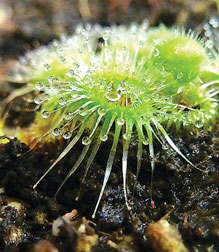|

Airborne car lands on neighbour's roof
Have you ever witnessed a flying car?
This unusual spectacle happened recently in Glendale, California.
 Although no one saw the flying car Paul Harrison, who lives down the
street heard it. "It was just smash, crash, boom" he said. "And my
neighbour shouted 'Paul come quick, I think there's been an accident'"
Paul and his neighbour couldn't believe what they saw. Although no one saw the flying car Paul Harrison, who lives down the
street heard it. "It was just smash, crash, boom" he said. "And my
neighbour shouted 'Paul come quick, I think there's been an accident'"
Paul and his neighbour couldn't believe what they saw.
A Cadillac was resting on a roof of a house in their neighbourhood!
Galina Wynn and her husband were driving the Cadillac when it went
airborne and landed on a neighbour's house. She says they came down the
hill and couldn't stop as they turned the corner.
"As soon as we hit the corner, the air-bags deployed and I didn't
even see where we were going from there," Wynn said.
Wynn says when she opened the door she saw the edge of the roof.
The back end of the car came to rest on the edge of a retaining wall.
Paul who had come with a ladder and helped the Wynns off the roof. Both
of them were not hurt and also a man inside the house when the crash
happened was not injured. "There was one person inside the house but not
in the area of where the car landed," said Glendale Fire Batt. Chief Ron
Gulli. In order to remove the car, the fire department called for a
crane to do the heavy lifting. The car had major damage, and remarkably
the roof needed only minor repairs.
"I consider myself and my husband to be very, very lucky," said Wynn.
Glendale police towed the car and a preliminary report indicated
there was a mechanical issue with the car.
Blonde penguin found!
Penguins mainly found in islands in the sub-Antarctic waters and on
cool coasts of Africa, Australia, New Zealand and South America have a
dark back and a white belly.
But tourists travelling on a special cruise, organised by the
National Geographic Society in association with Linblad Expeditions,
were astonished to spot a "blonde" penguin at the edge of one of the
South Shetland Islands in the Antarctic region.
 Though the penguin looks like an albino, the bird actually appears to
have isabellinism, said penguin expert P. Dee Boersma of the University
of Washington in Seattle. The condition is a genetic mutation that
dilutes pigment in penguins' feathers, according to a 2009 study on
isabellinism published in the journal Marine Ornithology. Though the penguin looks like an albino, the bird actually appears to
have isabellinism, said penguin expert P. Dee Boersma of the University
of Washington in Seattle. The condition is a genetic mutation that
dilutes pigment in penguins' feathers, according to a 2009 study on
isabellinism published in the journal Marine Ornithology.
This results in a "uniform lightening" of a bird's dark colours,
turning the animal a greyish yellow or pale brown, the study said.
Though they technically represent separate conditions, the terms
"isabellinism" and "leucism" are sometimes used interchangeably. Leucism
is a mutation that prevents any melanin at all from being produced in
feathers. Albinism occurs when an animal produces no melanin at all
throughout its entire body.
For instance, scientists have observed the most cases of isabellinism
in gentoo penguins, which are found throughout the Antarctic Peninsula.
Magellanic penguins, which live on South American coasts, seem to have
the lowest incidences of the condition.
The rare chinstrap penguin has a condition called isabellinism,
experts say.
Carnivorous plants use tentacles to catapult prey into traps
It looks like a lovely flower and many insects especially fruit flies
hover about in order to gather nectar.
 Their craving and misjudgement result in they being caught and
crushed to death. The plant will use one of its deadly tentacles to
catch the prey and catapult it into a sticky trap. Their craving and misjudgement result in they being caught and
crushed to death. The plant will use one of its deadly tentacles to
catch the prey and catapult it into a sticky trap.
A type of rare sun-dew, Drosera glanduligera found in eastern
Australia uses this snapping tentacles to catch its prey.
This plant has puzzled scientists because it has two types of thin,
leaf protrusions that radiate outward. One type, the sticky,
bug-ensnaring glue tentacle, is common on carnivorous plants. But the
second type, the snap tentacle, lacks glue and makes jerking movements
that had until now gone unexplained. New experiments in the lab reveal
that D. glanduligera's snap tentacles - which can sense moving prey -
catapult insects directly onto the glue tentacles at the plant's centre,
where the prey is digested. What's more, the catapult system is very
effective - the insect almost never escapes, noted a new study
co-authored by Thomas Speck, of the Plant Mechanics Group at Germany's
University of Freiburg. Overall, the discovery shows how plants can
evolve to suit their needs, Speck said.
For example, D. glanduligera probably requires the catapult because
of constant hunger. As a fast-growing plant that lives for less than a
year, it requires a lot of nutrients, and therefore a lot of bugs. "It's
interesting to see how tiny the changes have to be to get a totally
different behaviour," Speck said.
Right: A sun-dew's long snap tentacles are seen touching the ground. |


